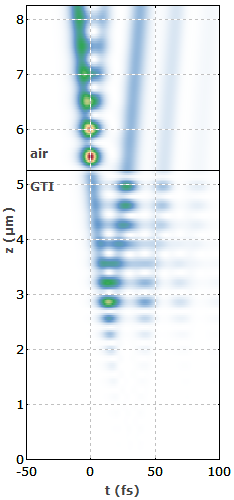Metal–semiconductor–metal Photodetectors
Acronym: MSM photodetector
Definition: fast photodetector devices based on metal–semiconductor (Schottky) contacts
More general term: photodetectors
German: Metall-Halbleiter-Metall-Photodetektoren
How to cite the article; suggest additional literature
Author: Dr. Rüdiger Paschotta
A metal–semiconductor–metal photodetector (MSM detector) is a photodetector device containing two Schottky contacts, i.e., two metallic electrodes on a semiconductor material, in contrast to a p–n junction as in a photodiode. It is thus a kind of Schottky barrier detector, but with two Schottky junctions. During operation, some electric voltage is applied to the electrodes. When light impinges on the semiconductor between the electrodes, it generates electric carriers (electrons and holes), which are collected by the electric field and thus can form a photocurrent.
One normally uses some kind of interdigited electrode structure, where the finger spacing can be as small as 1 μm. The electrode structure can also be ring-shaped, covering an approximately circular area. Light hitting the device from the side of the electrodes is partially blocked by the electrodes, which of course reduces the quantum efficiency. For higher quantum efficiency, there are back-illuminated devices, where the light impinges from the other side, so that it is not hindered by the electrodes. Another possibility is to use top illumination in combination with extremely thin gold contacts, which are partially transparent. An advantage of top illumination is that the achieved detection bandwidth is usually higher, since the carriers are generated closer to the contact.
For highest speeds, traveling-wave configurations are used, where the input light is sent through an optical waveguide containing the absorbing layer. The electrodes are deposited on top of the waveguide, forming a coplanar waveguide line for the generated microwave signal.
MSM detectors can be made faster than photodiodes. Their detection bandwidths can reach hundreds of gigahertz (with an impulse response function narrower than 1 ps), making them suitable for very high-speed optical fiber communications.
A practically important aspect is that MSM photodetectors, having a relatively simple planar structure, are particularly suitable for monolithic integration with other components on optoelectronic circuits.
Suppliers
The RP Photonics Buyer's Guide contains 1 supplier for metal--semiconductor--metal photodetectors.
Questions and Comments from Users
Here you can submit questions and comments. As far as they get accepted by the author, they will appear above this paragraph together with the author’s answer. The author will decide on acceptance based on certain criteria. Essentially, the issue must be of sufficiently broad interest.
Please do not enter personal data here; we would otherwise delete it soon. (See also our privacy declaration.) If you wish to receive personal feedback or consultancy from the author, please contact him e.g. via e-mail.
By submitting the information, you give your consent to the potential publication of your inputs on our website according to our rules. (If you later retract your consent, we will delete those inputs.) As your inputs are first reviewed by the author, they may be published with some delay.
Bibliography
| [1] | W. C. Koscielniak et al., “Dynamic behavior of photocarriers in a GaAs metal–semiconductor–metal photodetector with sub-half-micron electrode pattern”, Appl. Phys. Lett. 54 (6), 567 (1989), doi:10.1063/1.100933 |
| [2] | J. B. D. Soole and H. Schumacher, “InGaAs metal–semiconductor–metal photodetectors for long wavelength optical communications”, IEEE J. Quantum Electron. 27 (3), 737 (1991), doi:10.1109/3.81384 |
| [3] | C. Moglestue et al., “Picosecond pulse response characteristics of GaAs metal–semiconductor–metal photodetectors”, J. Appl. Phys. 70 (4), 2435 (1991), doi:10.1063/1.349395 |
| [4] | S. Y. Chou et al., “Ultrafast nanoscale metal–semiconductor–metal photodetectors on bulk and low-temperature grown GaAs”, Appl. Phys. Lett. 61 (7), 819 (1992), doi:10.1063/1.107755 |
| [5] | J.-W. Shi et al., “Metal–semiconductor–metal traveling-wave photodetectors”, IEEE Photon. Technol. Lett. 13 (6), 623 (2001), doi:10.1109/LEOS.2002.1159372 |
See also: photodetectors, photodiodes, bandwidth
and other articles in the category photonic devices




If you like this page, please share the link with your friends and colleagues, e.g. via social media:
These sharing buttons are implemented in a privacy-friendly way!